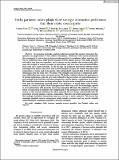Por favor, use este identificador para citar o enlazar a este item:
http://hdl.handle.net/10261/267931COMPARTIR / EXPORTAR:
 SHARE SHARE
 CORE
BASE CORE
BASE
|
|
| Visualizar otros formatos: MARC | Dublin Core | RDF | ORE | MODS | METS | DIDL | DATACITE | |

| Título: | Tricky partners: native plants show stronger interaction preferences than their exotic counterparts |
Autor: | Coux, Camille; Donoso, Isabel CSIC ORCID; Tylianakis, Jason M.; García, Daniel CSIC ORCID ; Dehling, Matthias D.; Stouffer, Daniel B. CSIC ORCID | Fecha de publicación: | 30-oct-2021 | Editor: | John Wiley & Sons | Citación: | Ecology - Ecological Society of America 102(2): e03239 (2021) | Resumen: | In ecological networks, neutral predictions suggest that species’ interaction frequencies are proportional to their relative abundances. Deviations from neutral predictions thus correspond to interaction preferences (when positive) or avoidances (when negative), driven by nonneutral (e.g., niche-based) processes. Exotic species interact with many partners with which they have not coevolved, and it remains unclear whether this systematically influences the strength of neutral processes on interactions, and how these interaction-level differences scale up to entire networks. To fill this gap, we compared interactions between plants and frugivorous birds at nine forest sites in New Zealand varying in the relative abundance and composition of native and exotic species, with independently sampled data on bird and plant abundances from the same sites. We tested if the strength and direction of interaction preferences differed between native and exotic species. We further evaluated whether the performance of neutral predictions at the site level was predicted by the proportion of exotic interactions in each network from both bird and plant perspectives, and the species composition in each site. We found that interactions involving native plants deviated more strongly from neutral predictions than did interactions involving exotics. This “pickiness” of native plants could be detrimental in a context of global biotic homogenization where they could be increasingly exposed to novel interactions with neutrally interacting mutualists. However, the realization of only a subset of interactions in different sites compensated for the neutrality of interactions involving exotics, so that neutral predictions for whole networks did not change systematically with the proportion of exotic species or species composition. Therefore, the neutral and niche processes that underpin individual interactions may not scale up to entire networks. This shows that seemingly simplistic neutral assumptions entail complex processes and can provide valuable understanding of community assembly or invasion dynamics. | Versión del editor: | http://doi.org/10.1002/ecy.3239 | URI: | http://hdl.handle.net/10261/267931 | DOI: | 10.1002/ecy.3239 | Identificadores: | doi: 10.1002/ecy.3239 issn: 0012-9658 |
| Aparece en las colecciones: | (IMIB) Artículos |
Ficheros en este ítem:
| Fichero | Descripción | Tamaño | Formato | |
|---|---|---|---|---|
| Tricky_partners_native_plants_show_stronger_interaction.pdf | 733,3 kB | Adobe PDF |  Visualizar/Abrir |
CORE Recommender
PubMed Central
Citations
3
checked on 29-abr-2024
SCOPUSTM
Citations
13
checked on 10-abr-2024
WEB OF SCIENCETM
Citations
12
checked on 25-feb-2024
Page view(s)
105
checked on 01-may-2024
Download(s)
101
checked on 01-may-2024
Google ScholarTM
Check
Altmetric
Altmetric
Artículos relacionados:
NOTA: Los ítems de Digital.CSIC están protegidos por copyright, con todos los derechos reservados, a menos que se indique lo contrario.
